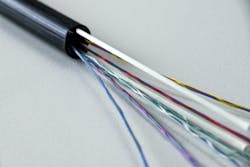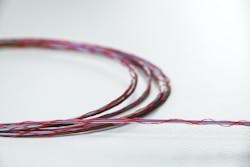How the U.K. Can Speed Up Its Fiber Rollout Without Compromising on Sustainability
Using technology to ensure fiber projects align with the need for a sustainable future.
The U.K. telecom sector is trying to deliver against the entwined targets of increasing the number of homes able to access gigabit connectivity and keeping carbon emissions as low as possible.
Ofcom reports1 that almost 75% of homes have access to gigabit-capable broadband, yet the U.K. still lags behind2 its European neighbors when it comes to homes passed by fiber. In rural areas, the challenges of rolling out FTTH are magnified3—just 40% of rural premises are now gigabit-capable, compared to 80% in urban areas.
In rural areas, traditional fiber rollout practices are too costly to both install and maintain and alternatives like wireless have a high environmental price tag. Network builders need solutions that are built on innovation and designed for the specific requirements of the U.K. market and prioritize sustainability.
The Fiber’s Greener on the Other Side
There are very clear business cases for telecom companies to prioritize the sustainability of their operations and networks. With a national push for sustainability and lower carbon emissions, consumer awareness of the environmental impact of each and every asset and product they use is growing. Today’s customers and consumers often have “green” ideals near the top of their priorities, whether that be in their homes or part of business projects.
A solid sustainability profile can also improve a company’s standing before investors. A transparent record of carbon emissions and a provable ESG strategy and reporting will find it easier to attract funding as more investment firms identify ESG as a priority.
The same goes for public project tenders. In 2013, the U.K. became the first country to make it compulsory for companies to include emissions data for their entire organization in their annual reports. Last year, it became the first G20 country to make it mandatory for firms to disclose climate-related financial information. Though this applied to large companies, the trend is clear and network builders shouldn’t be surprised to find proof of carbon offsetting a prerequisite for contracts.
Better sustainability practices can also deliver lower energy usage. Energy consumption constitutes between 20-40% of a network’s operating expenses, according to the GSMA. By reducing the energy consumption of their networks, operators can make significant cost savings. To unlock the potential of these savings, operators need to measure the sustainability of their networks all the way to the core. They have adopted the likes of Life Cycle Analysis concepts which consider all the life stages of a product, in order of the extraction of the raw materials, the manufacture of the product, the transportation involved, and its end of life.
Adopting and effectively communicating environmental policies creates reputational benefits that can generate further long-term business value. The evolution of sustainability strategies can also open new avenues and revenue for telecom service providers. For example, research by Boston Consulting Group has shown that younger consumers are willing to pay a 10% premium for sustainable “green” telco products.4 To reap these benefits and reduce emissions in their supply chains, service providers can negotiate with vendors to set their own renewable energy standards and targets.
So where in the business can telecom companies implement more efficient practices and what technologies can be adopted to help? From cutting operational emissions, for example reducing the number of visits to network sites in gas-guzzling vans, to using networks that need less raw material, the possibilities are many. But U.K. telecom companies must consider the best options and ensure that rural locations aren’t left behind.
The Rural Challenge
The dispersed nature of a rural area is the greatest hurdle that service providers must overcome when connecting houses, buildings, and businesses. Data must travel further to reach the end user. These isolated environments also mean that maintaining and repairing a fiber network is more challenging.
Wireless connectivity such as 4G and 5G can be great options in rural areas, as they can navigate the rough and robust terrains that separate the amenities much easier than cable. Somewhat surprisingly however, for the same amount of data, a 4G mobile network consumes 10 times more energy5 than fiber.
Operators have access to existing infrastructure in many rural areas, which if used can significantly lower an operator’s impact on the environment and time to deploy new networks, compared to strenuous digging and new installations. By upgrading these existing legacy networks—such as copper—to future-proofed technologies such as FTTH, companies can considerably reduce their energy dependencies.
Physical Infrastructure Access (PIA) is one solution for fulfilling the need of boosting high-capacity broadband around the world. PIA provides service providers with the opportunity of fiber installation in the access network via the incumbent operator’s ducts and poles. However, operators who wish to use PIA infrastructure must comply with rules such as cable breaking loads and cable size.6 These two constraints create a significant challenge to cable design and consequently limit the number of fibers that can be contained within a cable sheath that contains breakable strength members.
The market, therefore, needs innovative solutions that enable operators to cut emissions but are also cost effective and high performing.
Small in Size, Big in Environmental Impact
Many leading fiber network bodies are aiming to point the industry toward a more sustainable future. The FTTH Council Europe, for instance, has created a sustainability committee7 with the aim to promote full fiber as the most sustainable access network technology—and an enabler of multiple applications which can also contribute to reducing the carbon footprint of our activities, such as remote working. It has called for the industry to work collectively8 to support one another and make their respective activities more carbon neutral.
By analyzing the overall impact per subscriber in a PON architecture,9 the "transportation" part only represents 5% and the "distribution" part 60%, but the "connection" part alone represents 35% of the overall carbon impact of the passive architecture. For a single-fiber connection cable, the carbon impact of the cable can be up to a hundred kilograms of CO2 equivalent per kilometer, but the fiber itself only accounts for around 2-3% of this. The rest comes from the protection elements surrounding the fiber.
ACOME Group, a member of the FTTH Council Europe’s sustainability committee, has designed a cable with PIA Compliance in mind, that also enables cost savings and greener operations in a number of use cases.
Its patented Nanomodule technology enables ACOME to manufacture cables that mirror the existing architecture of fiber infrastructure—cables made up of 12 modules. Due to PIA compliance and its restriction on cable size on existing poles, many installers have been forced to move from the conventional 12 fiber per module to 24 fiber per module. ACOME’s Nanomodule is able to maintain modules of 12-fiber, thanks to its density, which is 30% smaller than traditional cables (as shown in the following images).
The Nanomodule technology also addresses key pain points that installers face helping to reduce installation times by an average of three hours and countless hours of maintenance times for every kilometer of cable deployed. This is because the cable is grease and gel free,10 making it easy to handle and install and eliminates the need for fiber cleaning. As the technology does not require any fiber cleaning solvents, operators can avoid waste pollution from both the sealing and cleaning substances that are needed to maintain traditional cables.
The Nanomodule design saves thousands of pounds per kilometer deployed in cost savings and one ton of carbon per three kilometers of cables that are installed, calculated by ACOME.
Fit for Tomorrow’s Networking Needs
If operators take the time to assess their impact and evaluate their decisions regarding the environment, they can set clear goals for the future and follow strategies to implement positive changes to benefit their customers and the planet.
With innovative products from the whole fiber industry, operators can continue to commit to their environmental plans and legislative demands, while also cutting costs. It is possible to act and innovate on all stages of a product's life cycle in order to minimize its carbon impact. Whether it be the choice of materials, the production processes, the packaging or the distribution, each choice can have a positive impact on the environment.
REFERENCES
1. Ofcom, https://www.ofcom.org.uk/news-centre/2023/faster-full-fibre-broadband-now-available-to-over-half-of-uk-homes
2. FTTH Council Europe, https://www.ftthcouncil.eu/knowledge-centre/all-publications-and-assets/1707/european-ftth-b-market-panorama-2023
3. Rural Services Network, https://www.rsnonline.org.uk/project-gigabit-slow-in-making-progress-in-rural-areas#
4. World Broadband Association, https://worldbroadbandassociation.com/wp-content/uploads/2022/09/The-Importance-of-Environmental-Sustainability-in-Telecom-Service-Providers-Strategy-World-Broadband-Association-White-Paper.pdf
5. IDATE DigiWorld, https://fr.idate.org/content/uploads/2022/02/White-Paper_Fiber-for-a-sustainable-future.pdf
6. ACOME Group, https://www.acome.com/en/publications/446-expert-opinions/3038-nanomodule-uk-breakthrough-technology-fighting-back-against
7. FTTH Council Europe, https://www.ftthcouncil.eu/about-us/committees/sustainability-committee
8. ACOME Group, https://www.acome.com/en/publications/445-magazine/2976-acome-inside2-carbon-transition
9. FTTH Council Europe, https://www.ftthcouncil.eu/committees/sustainability/fibre-for-the-planet/1429/innovating-to-reduce-the-carbon-footprint-of-subscriber-connections
10. ACOME Group, https://www.acome.com/en/publications/446-expert-opinions/3120-waterproof-gel-optical-cables-both-useful-and-impractical
About the Author
Xavier Renard
Marketing Director, Telecom Infrastructure Business Unit, ACOME Group
Xavier Renard is Marketing Director, Telecom Infrastructure Business Unit at ACOME Group. He has over 15 years’ experience in Product and Strategic Marketing and over 20 years' experience in the Telecom and Datacom industries.
Developing his marketing skills at Nexans (now Aginode), he supported and commercialized new infrastructure connectivity product lines for the FTTH markets in Europe. His proven commercial experience led him to take the responsibility for the marketing team.
At Schneider-Electric, he streamlined portfolios relating to the building network infrastructures in EMEA, opened operations in new countries, and provided and executed a strategic vision to increase value through digitalization in smart buildings. Schneider-Electric’s commitment to sustainability, reflected in its award for the world’s most sustainable corporation by Corporate Knights in 2021, enabled him to learn how to assess the environmental impact of products. Continuing these efforts, Xavier joined ACOME—a company deeply involved in measuring and reducing its environmental footprint since the 1980s—in 2019 as Marketing Director of the Telecom Business Unit and became a Board Member of the FTTH Council Europe in 2022.
For more information, email [email protected] or [email protected] or visit www.acome.com/en. Follow ACOME Group on Twitter, LinkedIn, and Facebook.


